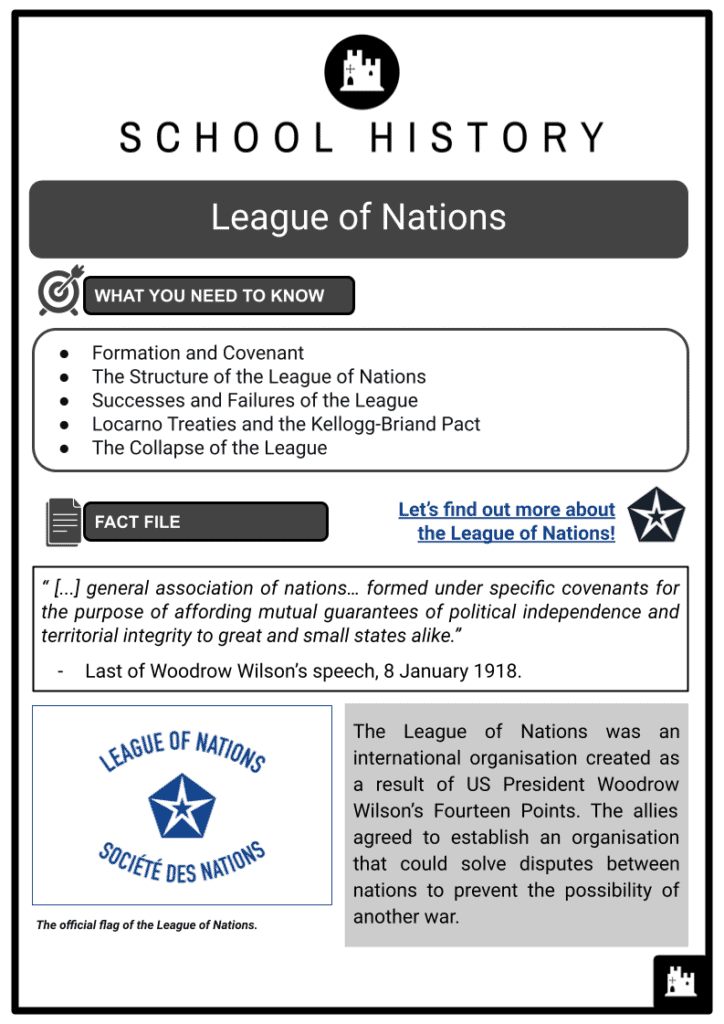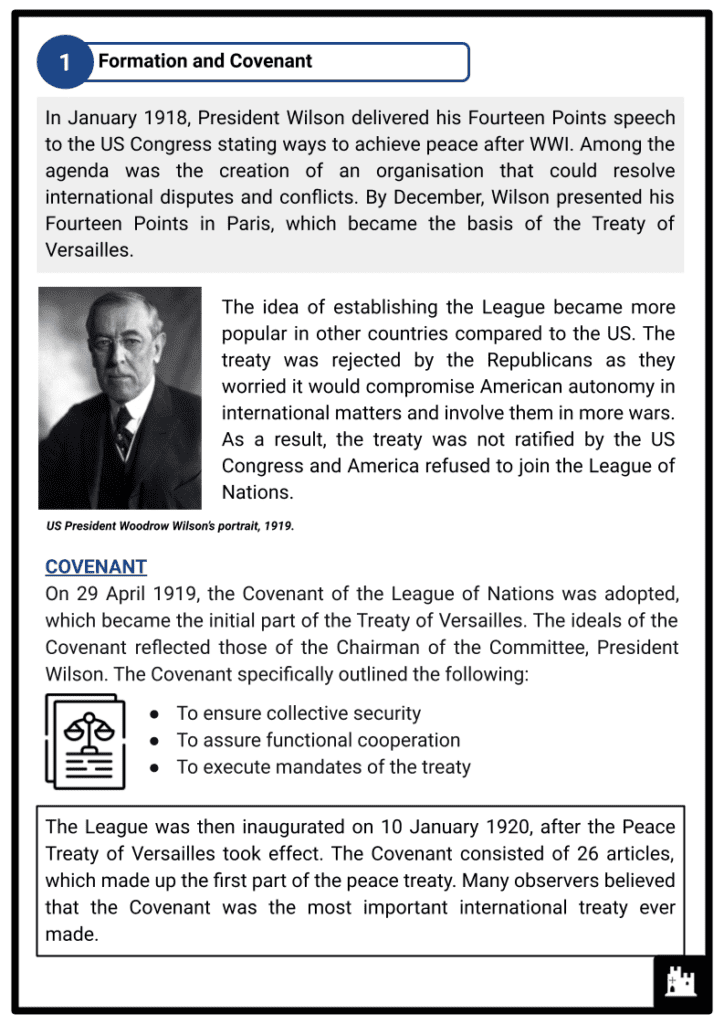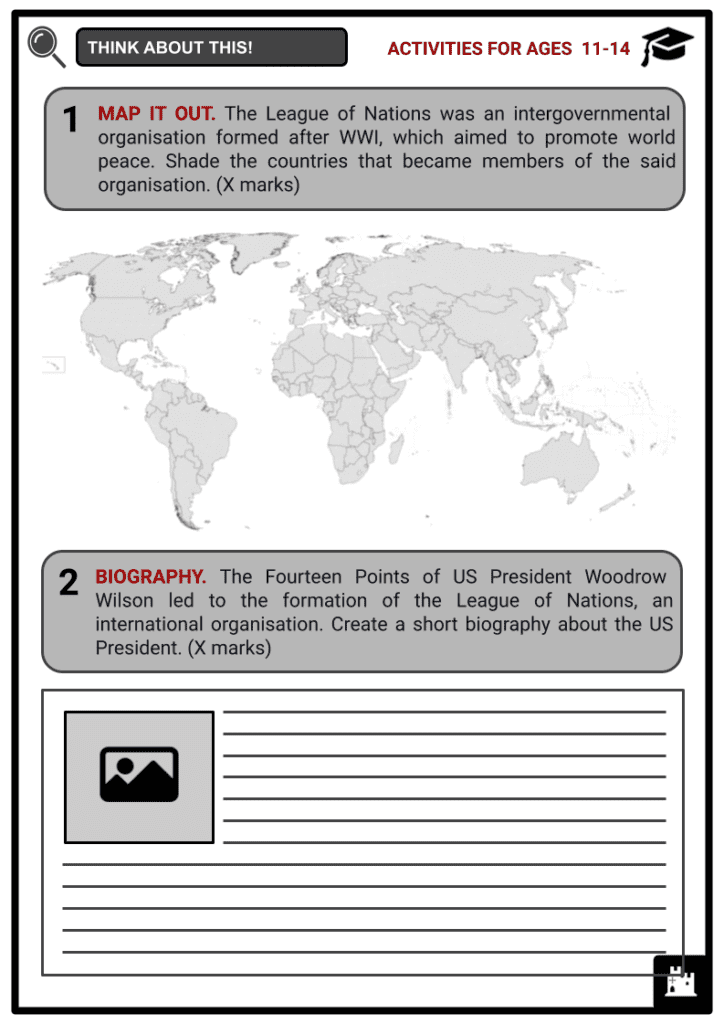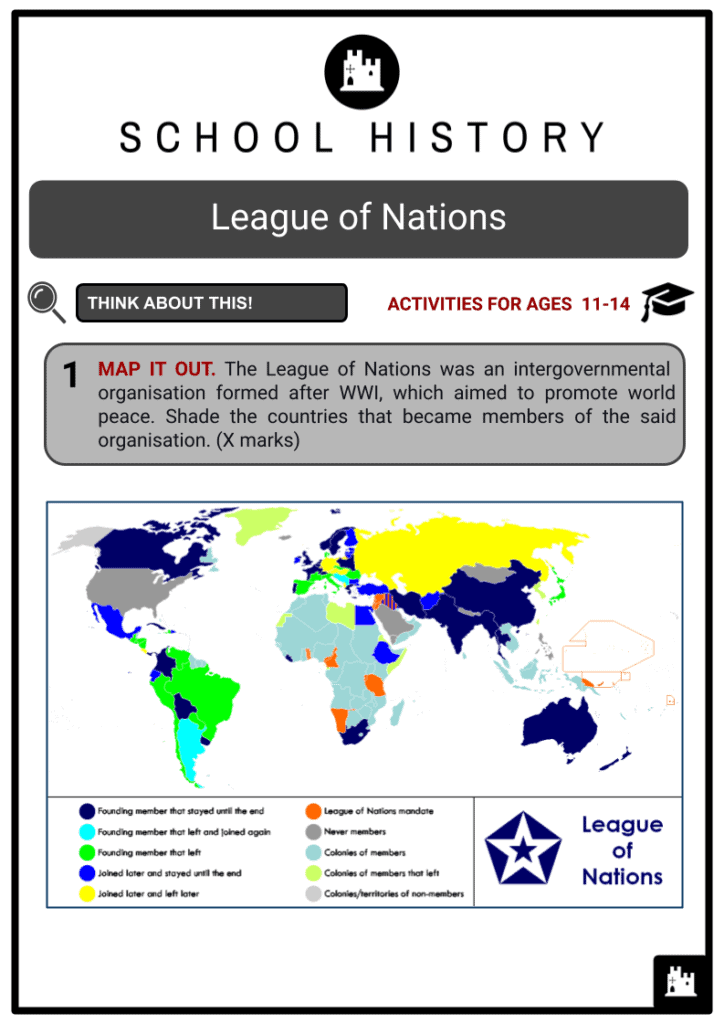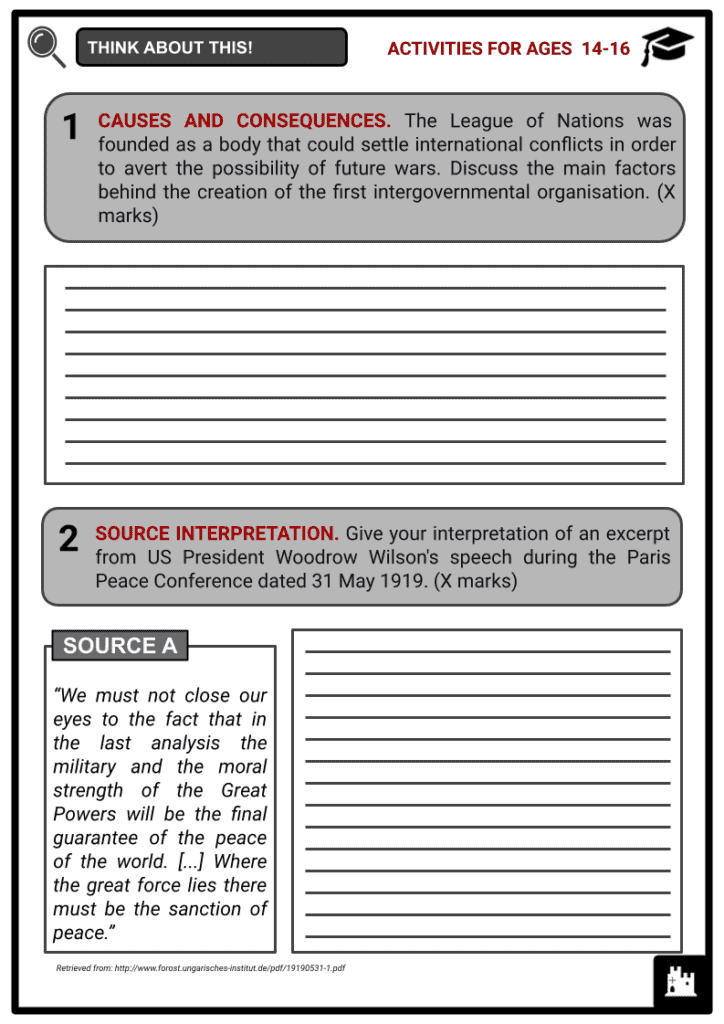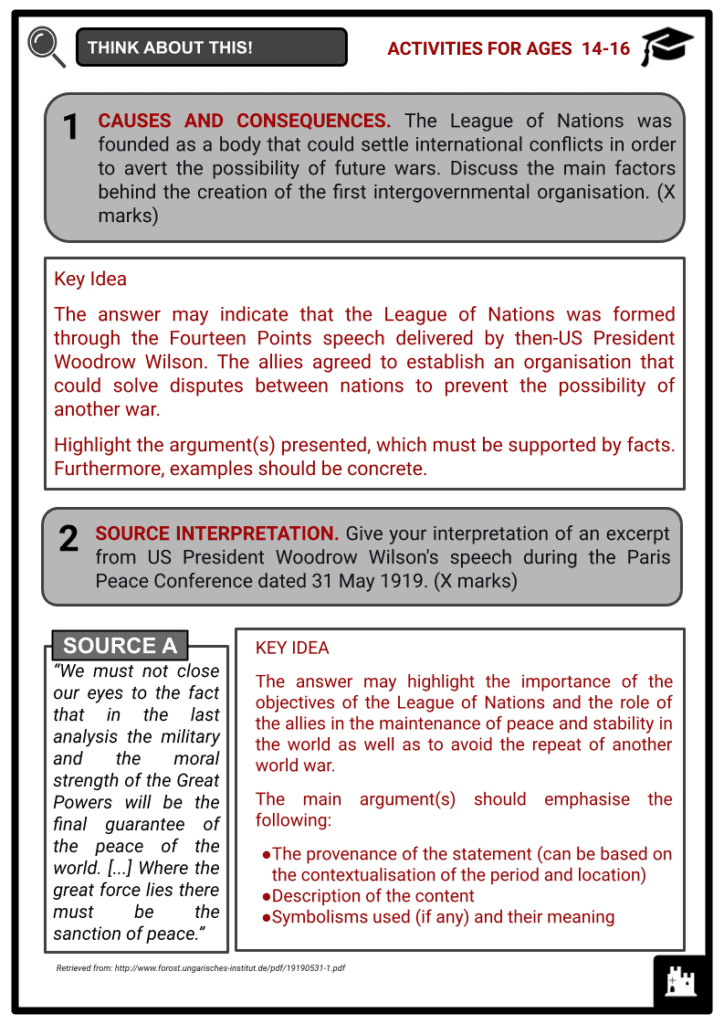League of Nations Worksheets
Do you want to save dozens of hours in time? Get your evenings and weekends back? Be able to teach about the League of Nations to your students?
Our worksheet bundle includes a fact file and printable worksheets and student activities. Perfect for both the classroom and homeschooling!
Summary
- Formation and Covenant
- The Structure of the League of Nations
- Successes and Failures of the League
- Locarno Treaties and the Kellogg-Briand Pact
- The Collapse of the League
Key Facts And Information
Let’s find out more about the League of Nations!
“ [...] general association of nations… formed under specific covenants for the purpose of affording mutual guarantees of political independence and territorial integrity to great and small states alike.”
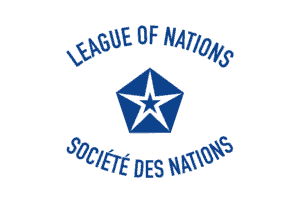
Last of Woodrow Wilson’s speech, 8 January 1918.
The League of Nations was an international organisation created as a result of US President Woodrow Wilson’s Fourteen Points. The allies agreed to establish an organisation that could solve disputes between nations to prevent the possibility of another war.
Formation and Covenant
- In January 1918, President Wilson delivered his Fourteen Points speech to the US Congress stating ways to achieve peace after WWI. Among the agenda was the creation of an organisation that could resolve international disputes and conflicts. By December, Wilson presented his Fourteen Points in Paris, which became the basis of the Treaty of Versailles.
- The idea of establishing the League became more popular in other countries compared to the US. The treaty was rejected by the Republicans as they worried it would compromise American autonomy in international matters and involve them in more wars. As a result, the treaty was not ratified by the US Congress and America refused to join the League of Nations.
COVENANT
- On 29 April 1919, the Covenant of the League of Nations was adopted, which became the initial part of the Treaty of Versailles. The ideals of the Covenant reflected those of the Chairman of the Committee, President Wilson. The Covenant specifically outlined the following:
- To ensure collective security
- To assure functional cooperation
- To execute mandates of the treaty
- The League was then inaugurated on 10 January 1920, after the Peace Treaty of Versailles took effect. The Covenant consisted of 26 articles, which made up the first part of the peace treaty. Many observers believed that the Covenant was the most important international treaty ever made.
- The Preamble was written as follows:“In order to promote international cooperation and to secure international peace and security by the acceptance of obligations not to resort to war, by the prescription of open, just and honourable relations between nations, by the term establishment of the understandings of international law as the actual rule of conduct among governments, and by the maintenance of justice and peoples with one another, the Powers signatory to this Covenant adopt this constitution of the League of Nations.”
The Structure of the League of Nations
THE COUNCIL
The Council had 4 permanent members, including Italy, France, Japan, and the UK, while temporary members could be voted in. It was responsible for taking on matters regarding world peace. They met 5 times a year and in emergencies.
THE SECRETARIAT
The League’s civil service section was responsible for preparing the agenda and keeping records. It was headed by a Secretary-General.
THE ASSEMBLY
The Assembly was composed of representatives from each member country. They met in a session held once a year. Each member had one vote to recommend an action to the council and accept a country in.
OTHER BODIES
- The PCIJ was intended to manage peaceful settlements of international disputes. Also known as the World Court, it could provide judgement or advice on issues.
- The ILO worked to end child labour and increase women’s rights in the workplace. Moreover, they convinced many countries to adopt an eight-hour workday/40-hour workweek.
- The RC oversaw the repatriation and settlement of over 400,000 refugees affected by WWI, especially those stranded in Russia.
- The Health Committee aimed to end diseases like malaria, leprosy, and yellow fever. Campaigns were conducted to end such epidemics.
- The SC sought to eradicate slavery in any form around the world. The agenda also included drug trafficking, prostitution, and forced labour.
- The DC aimed to limit the size of navies in order to avoid future wars. It also halted further military powers of Italy, Japan, and Germany.
- The PCOB mediated the production, manufacture, trade, and retail of opium by establishing a board that managed legal certificates and trading of narcotics.
MEMBERSHIP
- In 1920, Geneva became the permanent headquarters of the League of Nations primarily because of Switzerland’s neutrality. When the Covenant took effect on 10 January 1920, there were 23 founding members of the league, excluding the United States. The number increased to 33 by 10 March 1920. By the First Assembly, on November 15, 1920, members grew to 42 and by December, 6 more countries became members. By the Second Assembly in 1921, Estonia, Latvia, and Lithuania became members. Three more members were then accepted leading to the Fourth Assembly. Egypt was the last to join in 1937.
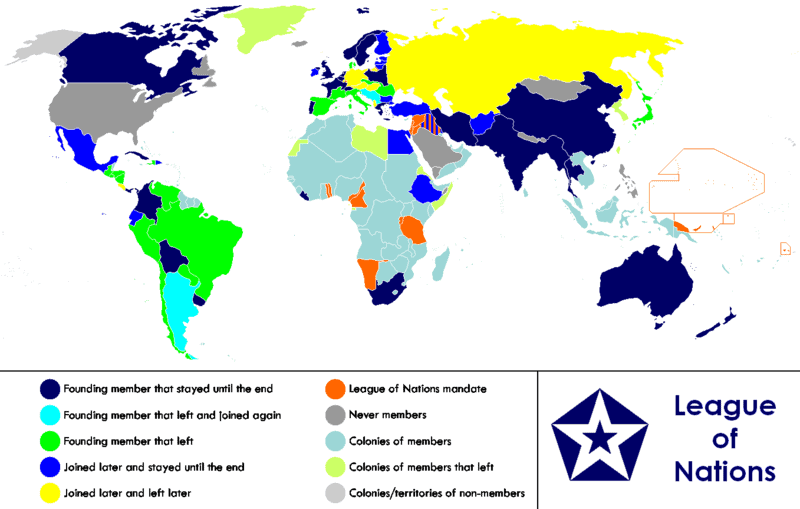
Map showing the League of Nations membership from 1920 to 1945
Successes and Failures of the League
- ALAND ISLANDS. In 1921, the League was able to mediate the territorial conflict between Sweden and Finland over the Aland islands located midway between the two countries. Despite being an exclusive Swedish-speaking territory, the islands remained part of Finland, honouring its sovereignty since the early 1900s.
- UPPER SILESIA. Before the entrance of the League, Upper Silesia was set to determine whether to join Germany or Poland through a plebiscite as stated under the Treaty of Versailles. The votes cast favoured Germany and resulted in a Third Silesian Uprising. In 1922, the League intervened and conducted an investigation, which resulted in a split. Both countries, as well as the majority of Upper Silesians, agreed.
- GREECE AND BULGARIA. In 1925, Greek soldiers invaded Bulgaria after an incident on the sentry border of both countries. Bulgaria asked the League to settle the dispute. As a result, the League ordered Greece to withdraw their troops and to provide the necessary compensation to Bulgaria. The Greeks complied but resented the unfair treatment by the League and particularly that of Italy.
- MOSUL. In 1926, the former Ottoman province of Mosul was assigned to Iraq despite the Turkish claim of ancestral domain. The League was able to resolve the dispute between the countries through an A-mandate over Iraq.
- LIBERIA. In 1930, after an investigation conducted by the League on rumours of forced labour in Liberia, President Charles D.B. King, along with his vice president and a number of government officials, resigned upon implication. The League then suggested trusteeship over Liberia if reforms were not carried out.
- VILNA. After WWI, the city of Vilna, which was dominated by a Polish population, was made the capital of Lithuania. In 1920, during the Polish-Soviet War, Polish troops invaded the city. The League condemned the action but the Poles refused to withdraw. They instead made a unification Act, which put Vilna in Poland (Wilno). With Poland being a buffer zone for the possibility of war against Russia, Britain and France did not send troops to back up the League. As a result, Wilno was recognised in 1923 as a Polish town and remained so until 1939.
- INVASION OF THE RUHR. When Germany failed to pay reparations under the Treaty of Versailles, France and Belgium invaded the industrial region of Ruhr in Germany, which was a direct violation of the League’s purpose. The League did nothing as France was a significant member of the association, while Britain did not want to upset a close ally. This act eventually led to the breakdown of the League’s own rules.
- CORFU.
Brought about by the murder of Enrico Tellini, an Italian general, and his staff while examining the Greek side of the border, Benito Mussolini demanded Greece pay reparations and eventually invaded the Greek island of Corfu. The invasion caused 15 deaths. As a result, the League condemned Mussolini’s action and required him to pay Greece. After initially agreeing with the terms, Mussolini was able to manipulate the League into changing its decision. In the end, Greece was forced to apologise and made immediate payment to Italy. - MANCHURIAN INCIDENT. In 1931, Japan took control of Manchuria, part of China, and bombarded the Chinese city of Shanghai. Despite China’s plea for help from the League of Nations, the members did not respond out of self-interest. As a result, control of Manchuria remained under the Japanese until the Soviet invasion of the region and its return to China at the end of WWII in 1945. Among others were the Chaco War between Paraguay and Bolivia between 1932 and 1935, the Italian invasion of Abyssinia in 1935, the Spanish Civil War between 1936 and 1939, and the rearmament of the Axis powers.
Locarno Treaties and the Kellogg-Briand Pact
- At the time of Gustav Stresemann’s leadership of Germany, the country began to open its doors to the international community through foreign affairs and treaties. In 1925, Germany agreed to settle border disputes with France, Belgium, Poland, and Czechoslovakia through the Locarno Pact.
- In October 1925, representatives from Britain, France, Germany, Italy, Belgium, Poland and Czechoslovakia met in Locarno, Switzerland, to discuss world affairs.
LOCARNO PACT, 1925
- Germany finally accepted the new borders with France and Belgium that had been decided in the Treaty of Versailles, and Britain and Italy agreed to protect France if Germany infringed on these borders. Germany also accepted that the Rhineland would stay a demilitarised zone.
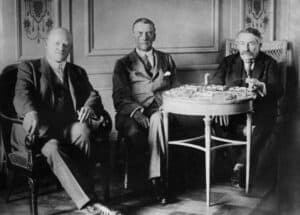
Image showing the signing of the Locarno Pact with Gustav Stresemann, Austen Chamberlain, and Aristide Briand, in 1925 - France and Germany agreed to settle any international disputes through the League of Nations. The agreements seemed to resolve the remaining problems from WWI. France finally felt its borders were secure and Germany had shown improved goodwill towards France.
- In January 1927, the Inter-Allied Military Commission, which oversaw German disarmament, was dissolved. Moreover, Germany joined the League of Nations in 1926. This meant that the only major European power that was not in the League was the U.S.S.R.
KELLOGG-BRIAND PACT, 1928
- On August 27, 1928, the Kellogg-Briand Pact was signed to outlaw war. Also known as the Pact of Paris, the agreement sought to prevent future world wars. With American peace advocates and the French Minister of Foreign Affairs, the initial bilateral agreement, the Kellogg-Briand Pact, outlaw war between the US and France.
- The pact specified that the declaration of offensive war was illegal and not military acts of self-defence. The final version of the agreement outlawed war as an instrument of national policy and the second called upon signatories to settle their disputes by peaceful means.
- Initially signed by fifteen countries, the Kellogg-Briand Pact became internationally popular as it gained an additional forty-seven nations. The agreement was eventually ratified by the US Congress. By contrast, the pact failed to prevent the Second World War as it did not clearly stipulate the definition of ‘self-defence’. Moreover, signatories had no way of imposing sanctions or punishment on those who disobeyed, like in the case of Japan invading Manchuria in 1931.
The Collapse of the League
THE GREAT DEPRESSION
- From 1929 until 1939, much of the world was economically paralysed because of the Great Depression. After the period of austerity in the US known as the Roaring Twenties, the stock market experienced a drastic decline that came to be known as the Wall Street Crash. The economic depression of many countries had a number of political implications, including the fate of the League of Nations. The Depression provoked the following from countries:
- heightened self-interest instead of collective security,
- greater attention on the domestic economy than international peacekeeping and justice,
- a rise in extremist parties in Germany which later gave way to the rise of the Nazis.
THE MANCHURIAN CRISIS
- In September 1931, Japan asserted that Chinese soldiers sabotaged the Manchurian railway, which was an important trading route for both China and Japan.
- In February 1932, Japan invaded the Chinese region of Manchuria. Between January to March 1932, Japan bombarded and invaded the Chinese city of Shanghai. As a result, China appealed to the League of Nations for help.
- In April 1932, the League sent delegations to Manchuria led by Lord Lytton to observe the situation. The delegation condemned Japan’s invasion and ordered it to leave. Japan rejected the order and walked out of the League.
- In July 1937, after the failure of the League to send support, Japan invaded China.
THE ABYSSINIAN CRISIS
- In December 1934, territorial conflict broke out between Abyssinia and Italian Somaliland.
- By January 1935, Abyssinian emperor Haile Selassie appealed to the League of Nations for arbitration. In response, the League banned the sale of arms to either side. That same year, in September, a five-power committee was sent to arbitrate. As a result, the committee suggested that Italy take part in Abyssinia. Italy responded with an invasion, first attacking Red Cross hospitals with poison gas.
- While Britain and France refused to intervene, the Hoare-Laval Pact leaked in December 1935, which gave details of giving Abyssinia to Italy.
- By May 1936, Italy invaded Abyssinia, while the League of Nations did next to nothing.
EFFECTS AND CONSEQUENCES OF THE CRISIS
- The Manchurian and Abyssinian crises both contributed to the collapse of the League of Nations. The crises implied the following:
- A strong nation had the power to ignore orders from the League.
- The delayed response of the League showed uncertainty and weakness.
- Members could not agree on definite sanctions.
- Major members, Japan, France, Italy, and Britain, all betrayed the League.
- The League was unable to protect smaller nations.
- In addition, the League also failed to avert incidents that preceded the Second World War.
- Germany, led by Hitler, left the League.
- Hitler publicly denounced the League and the Treaty of Versailles and began the rearmament of the German army.
- The League’s Disarmament Committee obviously failed.
- Germany invaded the Rhineland again.
- Italy left the League.
- Germany reunited with Austria, which disobeyed the peace treaty.
- Following the policy of appeasement and ignoring the League, Britain and France granted Sudetenland to Hitler through the Munich Agreement.
- After the Spanish Civil War, Spain left the League. World War II began.

